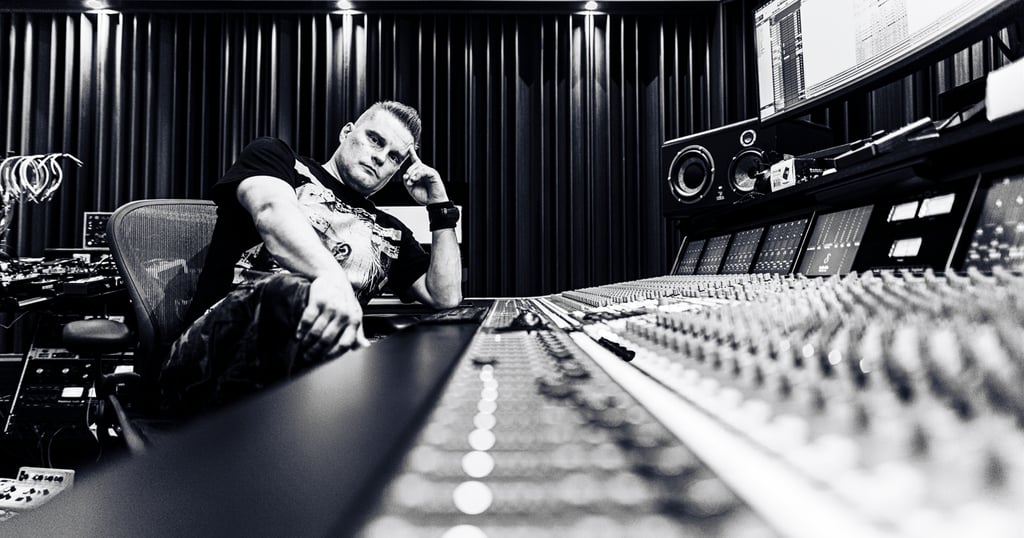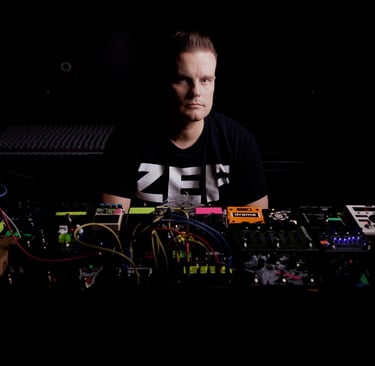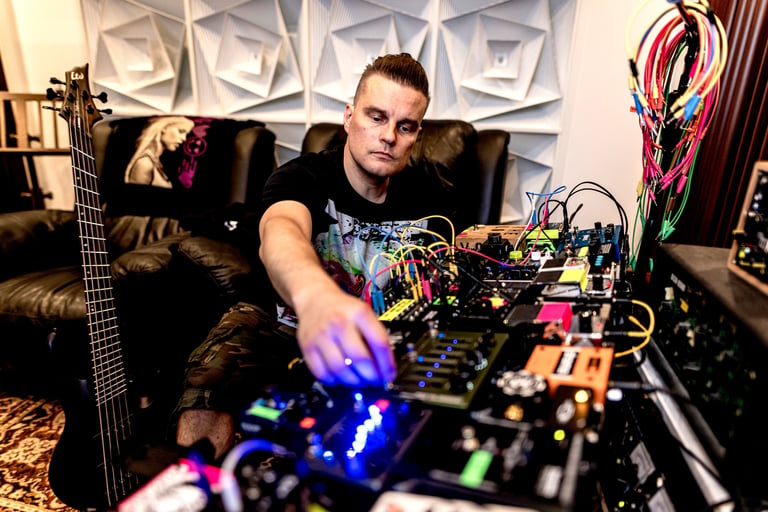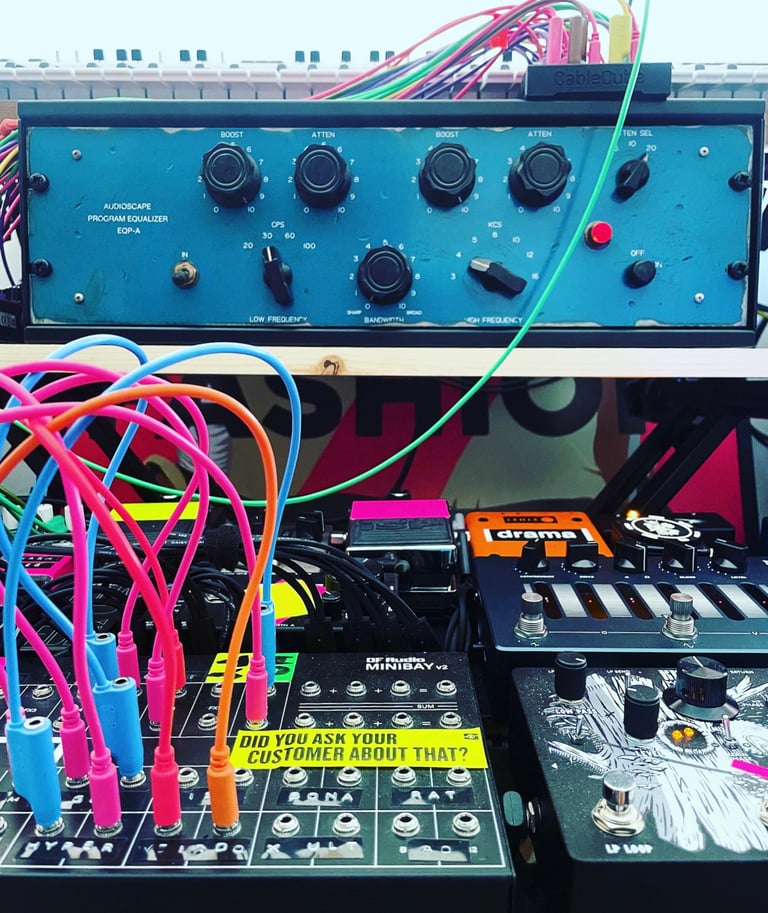pro bass player: nipa @readyplayerbass


Nipa is an electronic musician, bass player, and a Darkglass Artist from Finland. He has collaborated with the likes of Alexi Laiho and Wheel.
DF Audio interviewed him about his pedal rig.
Photos by Léo Margarit.
“I have a lot of different kinds of gear, so both creativity and effectivity come down to how things are connected. Nothing kills the buzz quicker than crawling under the table disconnecting and re-connecting instruments. In a multistandard system where pedals, eurorack, DAW, experimental gear, old and new line level audio equipment and amps have to play nice together, the overall patching strategy is actually mission-critical.”




Nipa’s main distortion bass board includes three DF Audio patchbays, along with a specific array of utility devices.
Sound designing multi-band bass distortion.
"The way I have everything set up is that, I can come out of the board at any point and return to the board at any point in the audio chain. This can be done multiple times, allowing me to patch my favourite rack gear anywhere between pedals - or vice versa. The inserts can be full-spectrum or frequency band-specific, so it’s a really powerful setup”.


“I currently have three DF Audio patchbays on my main studio board. This board is the one I take with me to the bigger studios too. It’s a really cool system and one that provides the ultimate flexibility for bass distortion. I can always also hook the board up with another patchbay-driven board, such as my modulation board, and run a powerful matrix.”
Nipa considers pedals and rack mount gear equally important in sound design, and they are often used interchangeably in his workflow.
“Modern pedals can simply do what no rackmount gear can. On the other hand, nothing beats the sound of a Chandler TG12345, for example. Why not rely on both worlds when working OTB?”
“The DF Audio patchbays have become an integral part of my effects pedal setup. They allow me to connect my pedals in every imaginable configuration to each other and to other outboard gear, DAW, and amps. In fact, this setup allows me to create patches that are otherwise impossible. I love the immediacy, too. Together with solutions to optimize impedances and noise floor, this has truly revolutionised my workflow.”


Nipa's bass recording rig in a studio in Sweden, 2023.
“Obviously, you need to understand some basic concepts to operate passive patchbays like this noise-free, but once you do, it’s a lot of fun. I’ll provide some tips for people getting into it.”
NIPA'S DON'TS
> Never connect your bass or guitar directly to the patchbay. I use a dedicated input device, but you can basically connect your instrument to any effects pedal, and then connect that pedal to the patchbay as the input device.
> Never connect an amp or sound card directly to the patchbay. I use several dedicated output devices. In the minimum, it's wise to use some kind of galvanic isolation when coming out of the board.
NIPA'S DOS
> Use a high quality isolated switching mode power supply for your pedals, like the Cioks DC7.
> Mind impedance differences between the various inputs and outputs of your operating environment. A basic example is using a re-amp box when running DAW into your pedals.
> Integrate a good noise reduction system on your pedalboard. Patchbays can get noisy with sub-line level signals and guitar pedals. Visit my Instragram @readyplayerbass for examples of state-of-the-art noise reduction in this setting. Also, check out the Decimator G-String for separating the points where your instrument is monitored and where the actual noise takes place.
> Mind capacitance. Long cable runs build up capacitance, which will filter out your high frequencies. Use short patch cables and patch out pedals that are not in your active audio chain. Use buffers where needed. In addition to the buffers that are always on my signal chain, I have 2 free-floating buffers that can be patched anywhere.
"As with any audio device, you have to put in the hours to understand how to use these patchbays properly. But once you have your converters and utility modules set up, it's really a set-and-forget operation. I can heartily recommend this approach to curious musicians of any level. It's so much fun!"
Be sure to check out Nipa's Instagram @readyplayerbass for a swagger of inspirational pro audio tips and tricks.
featured artist:


Nipa is an electronic musician, bass player, and a Darkglass Artist from Finland. He has collaborated with the likes of Alexi Laiho and Wheel.
Photos by Léo Margarit.




Nipa’s main distortion bass board includes three DF Audio patchbays, along with a specific array of utility devices.
Sound designing multi-band bass distortion.


“I currently have three DF Audio patchbays on my main studio board. This board is the one I take with me to the bigger studios too. It’s a really cool system and one that provides the ultimate flexibility for bass distortion. I can always also hook the board up with another patchbay-driven board, such as my modulation board, and run a powerful matrix.”


Nipa's bass recording rig in a studio in Sweden, 2023.
“Obviously, you need to understand some basic concepts to operate passive patchbays like this noise-free, but once you do, it’s a lot of fun. I’ll provide some tips for people getting into it.”
NIPA'S DON'TS
> Never connect your bass or guitar directly to the patchbay. I use a dedicated input device, but you can basically connect your instrument to any effects pedal, and then connect that pedal to the patchbay as the input device.
> Never connect an amp or sound card directly to the patchbay. I use several dedicated output devices. In the minimum, it's wise to use some kind of galvanic isolation when coming out of the board.
NIPA'S DOS
> Use a high quality isolated switching mode power supply for your pedals, like the Cioks DC7.
> Mind impedance differences between the various inputs and outputs of your operating environment. A basic example is using a re-amp box when running DAW into your pedals.
> Integrate a good noise reduction system on your pedalboard. Patchbays can get noisy with sub-line level signals and guitar pedals. Visit my Instragram @readyplayerbass for examples of state-of-the-art noise reduction in this setting. Also, check out the Decimator G-String for separating the points where your instrument is monitored and where the actual noise takes place.
> Mind capacitance. Long cable runs build up capacitance, which will filter out your high frequencies. Use short patch cables and patch out pedals that are not in your active audio chain. Use buffers where needed. In addition to the buffers that are always on my signal chain, I have 2 free-floating buffers that can be patched anywhere.
"As with any audio device, you have to put in the hours to understand how to use these patchbays properly. But once you have your converters and utility modules set up, it's really a set-and-forget operation. I can heartily recommend this approach to curious musicians of any level. It's so much fun!"
Be sure to check out Nipa's Instagram @readyplayerbass for a swagger of inspirational pro audio tips and tricks.
nipa @readyplayerbass
“I have a lot of different kinds of gear, so both creativity and effectivity come down to how things are connected. Nothing kills the buzz quicker than crawling under the table disconnecting and re-connecting instruments. In a multistandard system where pedals, eurorack, DAW, experimental gear, old and new line level audio equipment and amps have to play nice together, the overall patching strategy is actually mission-critical.”
Nipa considers pedals and rack mount gear equally important in sound design, and they are often used interchangeably in his workflow.
“Modern pedals can simply do what no rackmount gear can. On the other hand, nothing beats the sound of a Chandler TG12345, for example. Why not rely on both worlds when working OTB?”
“The DF Audio patchbays have become an integral part of my effects pedal setup. They allow me to connect my pedals in every imaginable configuration to each other and to other outboard gear, DAW, and amps. In fact, this setup allows me to create patches that are otherwise impossible. I love the immediacy, too. Together with solutions to optimize impedances and noise floor, this has truly revolutionised my workflow.”
"The way I have everything set up is that, I can come out of the board at any point and return to the board at any point in the audio chain. This can be done multiple times, allowing me to patch my favourite rack gear anywhere between pedals - or vice versa. The inserts can be full-spectrum or frequency band-specific, so it’s a really powerful setup”.
